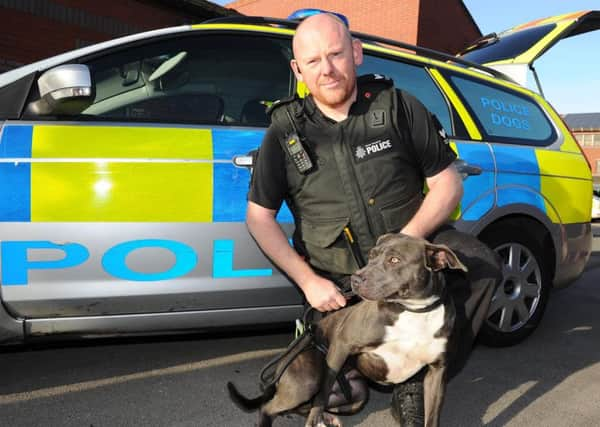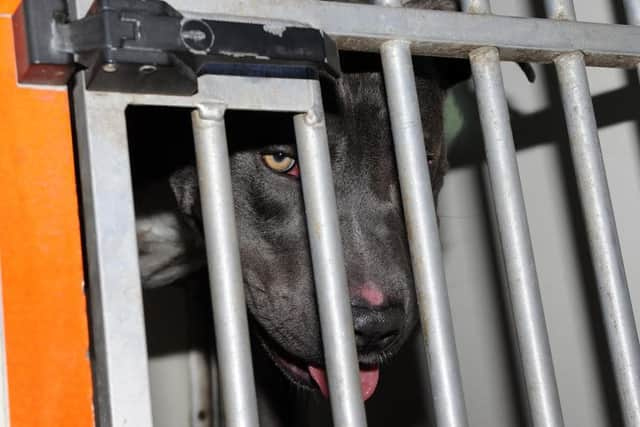Police taking the lead in banned dogs crackdown


Police chiefs know the dog fights are happening and investigations are under way to find and prosecute those involved.
The cruel sport was one of the reasons for the formation of South Yorkshire Police’s status dogs unit six months ago, with bosses keen to rid South Yorkshire’s streets of banned dog breeds before they kill or maim.


Advertisement
Hide AdAdvertisement
Hide AdDespite the Dangerous Dogs Act being introduced 25 years ago to ban dogs traditionally bred for fighting from Britain, South Yorkshire officers are still finding them today.
Pit bull terriers, the Japanese tosa, fila Brasileiro and dogo Argentino breeds are the four banned from Britain, but in South Yorkshire 53 dogs have been seized under dangerous dogs act legislation over the last six months.
All have been pit bull-type cross breeds, showing the physical characteristics of the banned breed.
Sergeant Matt Duffy, who runs the status dogs unit in Sheffield, said in addition to being used as fighting dogs the animals are also used by criminals for protection.


Advertisement
Hide AdAdvertisement
Hide AdHe said they are also paraded around by some for a ‘hardman’ status and there have been reports of them fighting on leads in public places for the ‘honour’ of having the ‘best dog on the estate’.
But he said that ‘worryingly’ there are some banned breed-type dogs living with families across Sheffield, whose owners simply bought them as cross-breeds without knowing their background and falling for the generic ‘cross-breed’ label.
“There is a reason these breeds are banned – they were traditionally bred for fighting and their instinct is to do that,” he said.
“There are people out there who breed these banned-type dogs fully aware that they are breaking the law but they do it for money because there is a market for them – whether it is for the underground activity of dog fighting, or for status or protection.
Advertisement
Hide AdAdvertisement
Hide Ad“But a lot of people buy them thinking they have a cross-breed and it isn’t until they grow up that they realise they have a pit bull.
“It may not be until it bites or acts aggressively that they realise what they have got and this is the danger of not going to reputable breeders for all dogs.
“Certain breeds have specific behavioural traits and for pit bulls their instinct is to fight, which is why we take this so seriously as we don’t want any fatalities.”
He said all reports of banned dogs are followed up by South Yorkshire Police and the owners are spoken to about the dangers of having them.
Advertisement
Hide AdAdvertisement
Hide AdPolice officers in the status dogs unit are trained to identify banned dogs and seize them.
Some owners, realising they are breaking the law, sign their dogs over to be destroyed and avoid going to court and facing a conviction.
Others challenge the assessment of their dogs and fight at court to keep them.
But not all banned dogs are automatically destroyed if courts consider that they do not pose a danger to the public, but their owners have to agree to adhere to a strict list of conditions or face prosecution.
Advertisement
Hide AdAdvertisement
Hide AdThe status dogs unit not only looks for banned breeds, but helps owners of other dogs which could pose a risk to themselves or others. Officers carry out home visits to assess risks and speak to dog owners about ways of keeping them, their families and members of the public safe.
Members of the unit also works in schools to educate children about responsible dog ownership and the dangers of banned breeds.
They also work with charities including the Blue Cross and RSPCA to encourage responsible dog ownership.
Sgt Duffy added: “We will always support responsible dog owners, but will robustly use dangerous dog and anti-social behaviour legislation where anybody uses a dog to threaten, cause fear or put our communities at risk.”
Advertisement
Hide AdAdvertisement
Hide Ad* Anyone with information on those with banned dogs or involved with breeding them or dog fighting can call South Yorkshire Police on 101 or Crimestoppers on 0800 555111.
THE LAW
It is against the law to have a pit bull terrier, Japanese tosa, fila Brasileiro and dogo Argentino or to sell, abandon, give away or breed from a banned dog.
Whether a dog is a banned ‘type’ depends on what it looks like, rather than its breed or name.
The characteristics of dogs are assessed to determine whether they are a banned type.
Advertisement
Hide AdAdvertisement
Hide AdBanned dogs can be seized without complaints having been made or any reports of them acting ‘dangerously’.
It is a dog owner’s responsibility to prove their animal is not a banned type.
Dogs can be handed over to the authorities to be destroyed without cases having to reach court if their owners agree.
Courts can impose an unlimited fine and, or, send dog owners to prison for up to six months for having a banned breed.
Advertisement
Hide AdAdvertisement
Hide AdIf courts deem a banned dog not to pose a danger to the public, they can be spared from death row but owners must abide by a strict list of conditions including neutering the dogs, microchipping them and keeping them on a lead and muzzled at all times when in public.
They must also be kept in a secure place where they cannot escape.
Owners must take out insurance and be aged over 16.